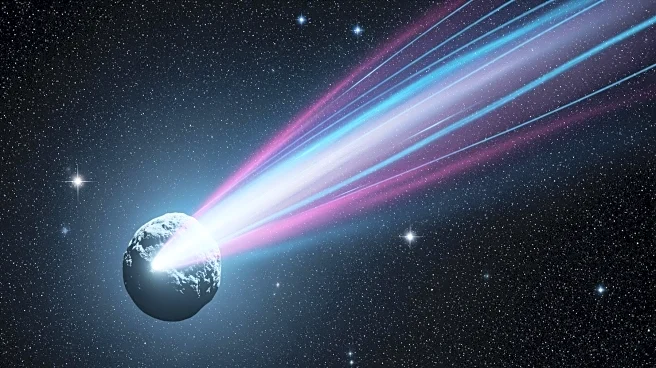What's Happening?
Astronomers have made a significant discovery involving the largest Oort Cloud comet ever detected, known as C 2014 UN271 or Bernardinelli Bernstein. The comet, which is over a billion miles from the Sun, is exhibiting activity typically not expected
at such distances. Using the Atacama Large Millimeter/submillimeter Array (ALMA), scientists detected carbon monoxide gas venting from the comet's surface. This activity is driven by volatile ices like carbon monoxide and carbon dioxide, which can vaporize under weak sunlight, creating jets that form a coma around the nucleus. The comet's nucleus is about 85 miles wide, and the detection of these gases provides insights into the primitive chemical composition of objects from the Oort Cloud.
Why It's Important?
The discovery of active jets in C 2014 UN271 challenges previous assumptions about comet activity at such distances from the Sun. This finding is crucial for understanding the early solar system's composition, as the gases escaping from the comet carry clues about the materials that formed planets. The ability to observe these gases before the comet reaches the inner solar system allows scientists to refine models of comet evolution and activity. This research could lead to a better understanding of how comets behave and evolve, providing insights into the solar system's history and the processes that govern cometary activity.
What's Next?
As C 2014 UN271 approaches its closest pass to the Sun in 2031, scientists anticipate observing new materials like methane and carbon dioxide escaping from the comet. These observations will help researchers understand how the comet's composition changes as it warms. The team plans to continue monitoring the comet to compare its behavior with other Oort Cloud objects, determining whether it is typical or an outlier. This ongoing research will contribute to a deeper understanding of cometary dynamics and the factors influencing their activity.
Beyond the Headlines
The study of C 2014 UN271 offers a unique opportunity to explore the raw materials that built the solar system. The comet's activity at such a distance suggests that frozen gases can become active even in the outer reaches of the solar system, providing a new perspective on cometary physics. This research highlights the importance of precise measurements and observations in distinguishing scientific signals from noise, advancing our knowledge of cometary behavior and the solar system's evolution.














